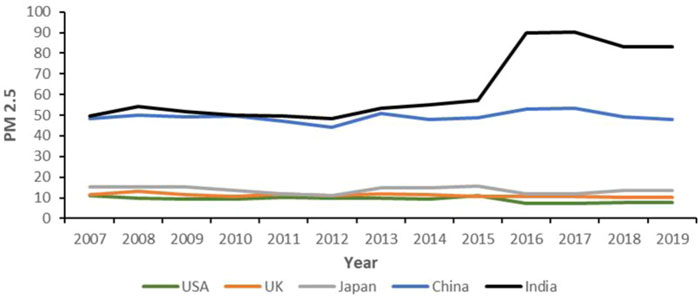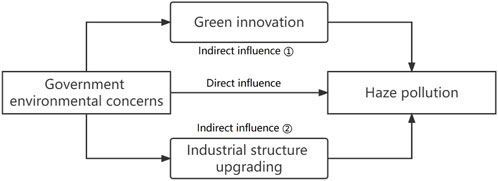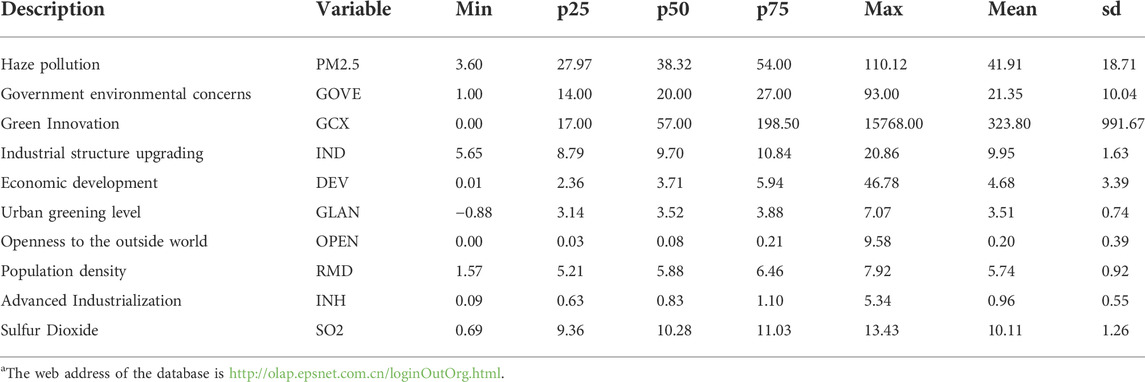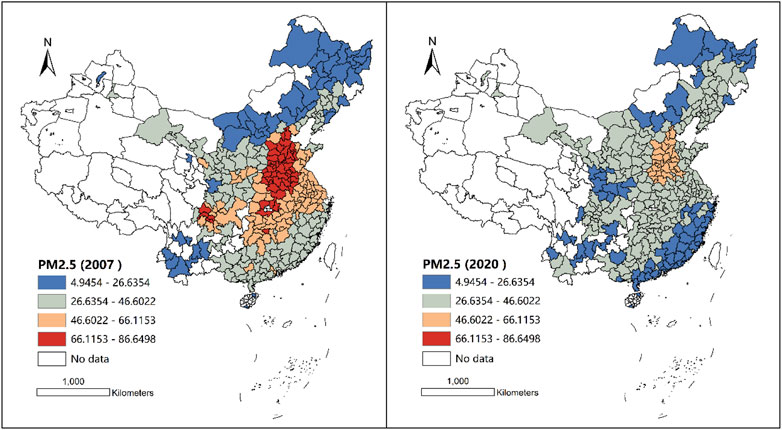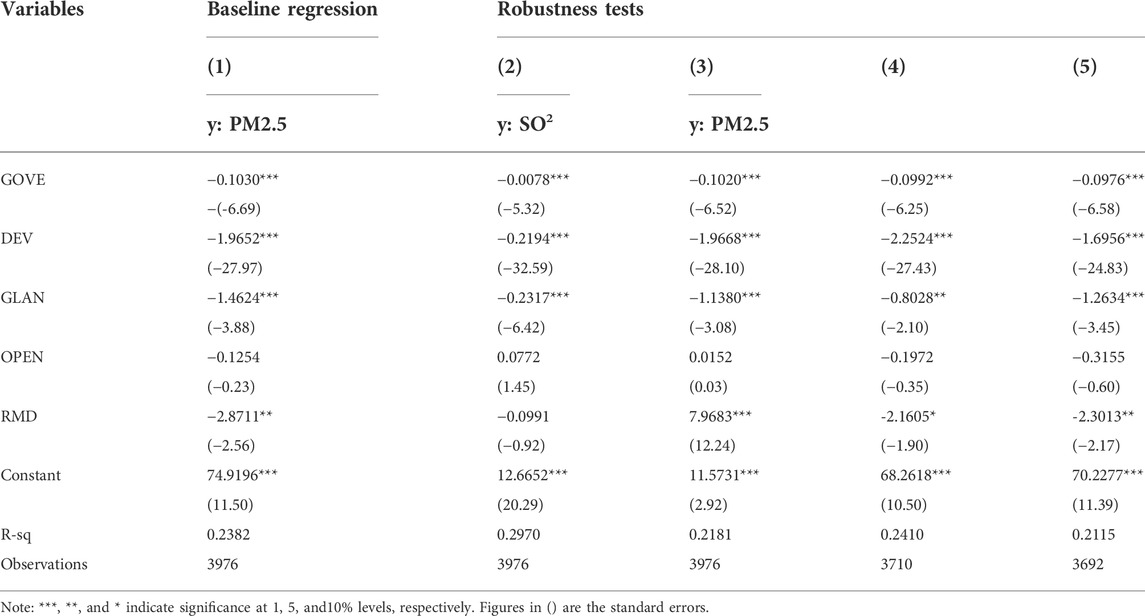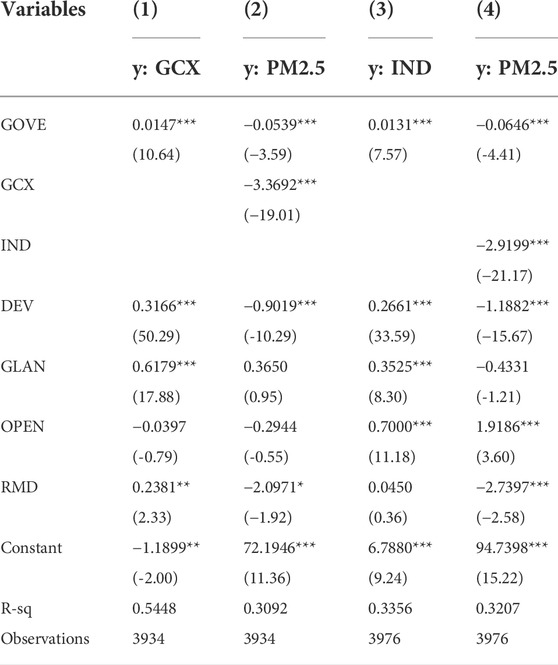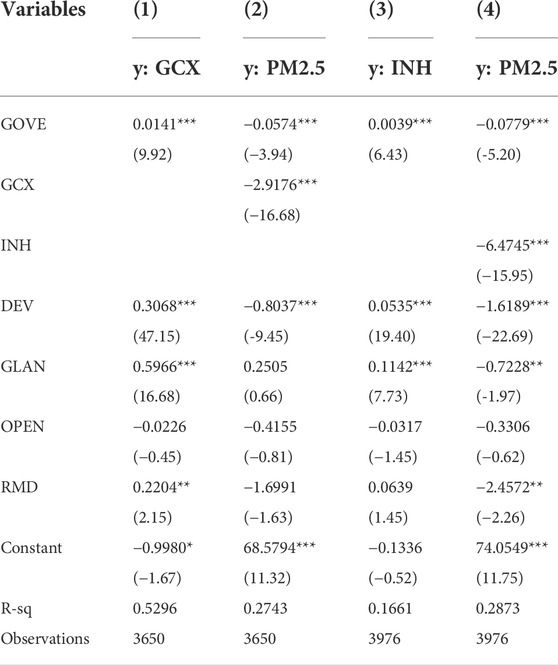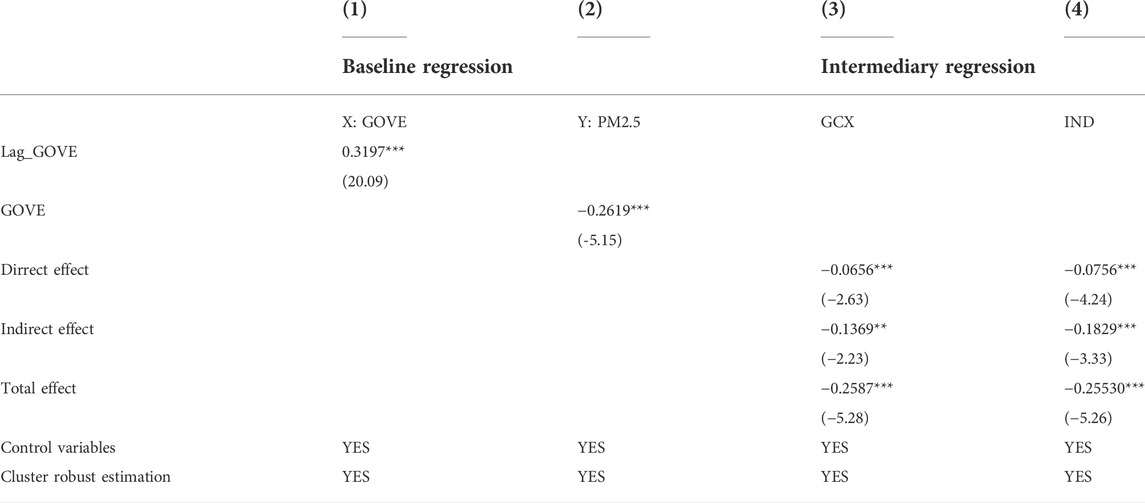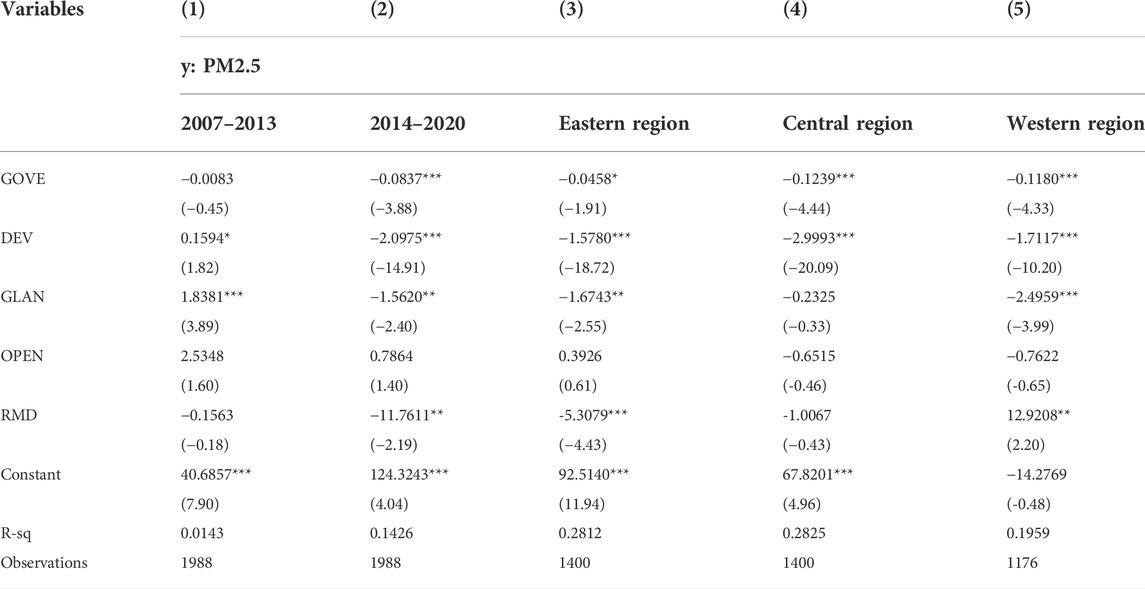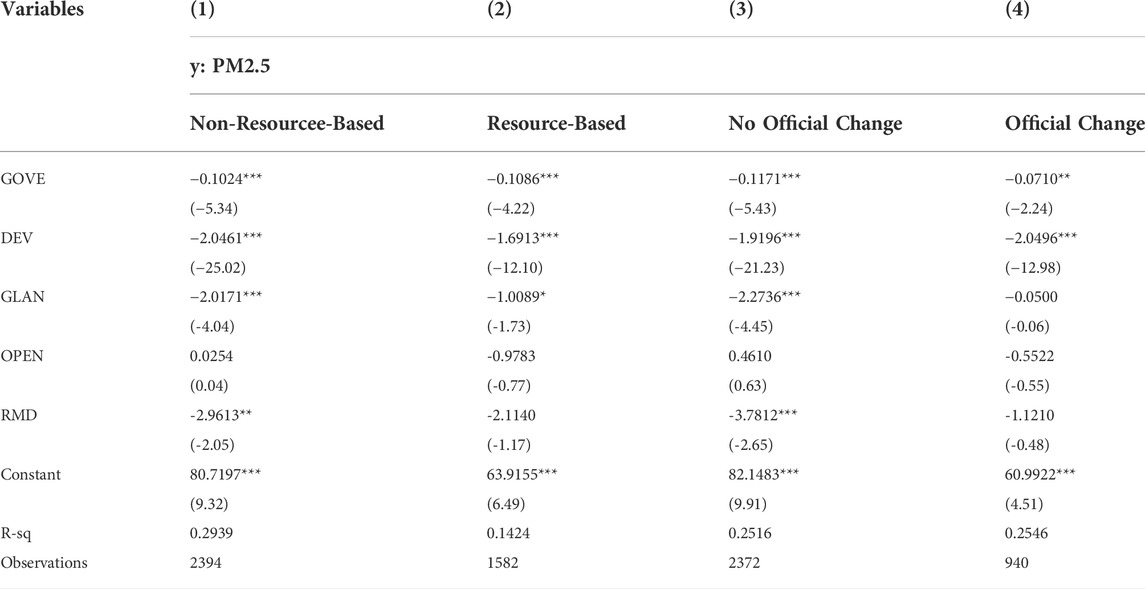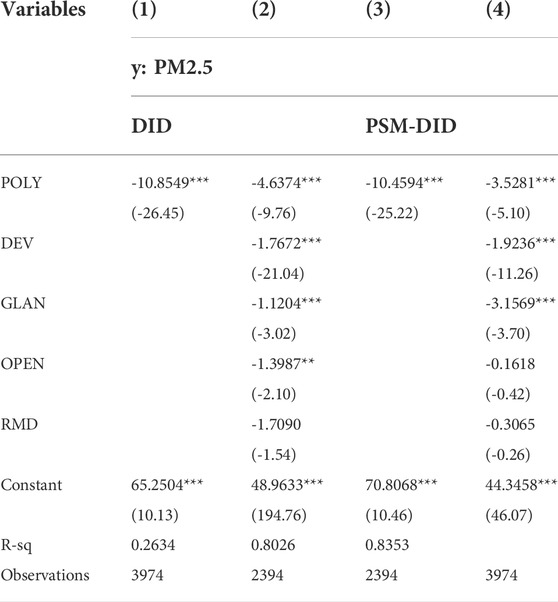How do government environmental concerns affect haze pollution?
- 1Xinjiang University, Ürümqi, China
- 2Ocean University of China, Qingdao, China
- 3Shandong University, Weihai, China
- 4Yangtze University, Jingzhou, China
Abstract: The air pollution problem, represented by the frequent occurrence of haze, has seriously affected the quality of China’s economic growth. Along with the in-depth implementation of the concept of sustainable development and the continued strengthening of the central government’s environmental accountability, local governments’ environmental concerns have also increased. Therefore, can the local government mitigate the haze pollution by an emphasis on environmental concerns? Based on theoretical analysis, this paper uses text analysis and machine learning to construct local government environmental concerns indicators, and selects a panel of 284 cities in China from 2007 to 2020 for research. The study shows that local government environmental concerns effectively reduce haze pollution, and the conclusion still holds after considering robustness. Local government ecological concerns can force cities to improve green innovation and industrial structure optimization, alleviating haze pollution. There are heterogeneous effects of local government environmental concerns on haze pollution under different regions, different resource endowments, different central assessment systems and different changes in government officials; the Difference-In-Difference results show that, in addition to local government environmental concerns, central government ecological concerns can also reduce haze pollution. Based on the above findings, the central government should further improve the officials’ appraisal system and give play to the government’s active role in environmental governance.
1 Introduction
Since the industrial revolution, human society has achieved significant enrichment of material civilization with a cost of depleting ecological civilization. Still, the massive use of fossil fuels such as oil and coal has caused severe air pollution problems (Kulmala, 2015), especially the frequent haze events that attracted the attention of countries all over the world. Haze pollution is defined as the phenomenon that the visibility is less than 10 km due to the dense accumulation of fine aerosol particles (Xu et al., 2016; Tao et al., 2012). According to scholarly research, haze pollution not only reduces visibility and causes traffic problems such as highway closures and airplane delays, but also introduces upon inhalation the heavy metals, sulfates and other harmful substances into the body, resulting in serious adverse effects on the human respiratory system and nervous system (Duan and tan, 2013; Zhang et al., 2020a). Because the United Kingdom, the United States and other developed countries have an earlier industrial establishment, haze pollution in these countries first appeared, such as the more famous Los Angeles photochemical smog event, London smog event and Donora haze event, etc. (Dong F. et al., 2019). In order to cope with the impact of haze pollution on production and living activities, the United Kingdom promulgated the Clean Air Act in 1956, trying to reduce air pollutants by reducing the use of energy such as coal. The United States has established an emission trading market and used the market mechanism to achieve the purpose of environmental protection (Hansell et al., 2003; Convey., 2020). With the transformation of the economic development mode and the effective implementation of environmental policies in developed countries, haze and other environmental problems have been better controlled (Schichtel et al., 2001). It can be seen from Figure 1 that during the investigation period from 2007 to 2019, the population of developed countries such as the United States, the United Kingdom, and Japan were exposed to the average annual concentration of PM2.5 below 15 μg/m3, maintaining a low level. On the contrary, developing countries are currently in the stage of industrialization and urbanization expansion, so the problem of air pollution is following the track of developed countries (Huang et al., 2014; Fu and Chen, 2017; Dong et al., 2021). As two specific developing countries, China and India have been plagued by smog in recent years, especially India. Driven by the government’s policy of focusing on industry and agriculture, industrial pollution is discharged wantonly, and straw is burned in large quantities (Ravindra et al., 2022). India’s air quality continues to deteriorate, and the annual average PM2.5 concentration rose from 49.44 in 2007 to 83.30 in 2019. Similarly, the rise of China’s economy depends on the heavy industry with high investment and high pollution. Although the Chinese government realizes that this dirty growth is not conducive to sustainable economic development and encourages the transformation to an intensive mode of economic development, the long-standing development model still has the problem of path dependence, resulting in more significant pressure on China’s haze control (Zhang and Cheng, 2009; He et al., 2012; Shen et al., 2020). Therefore, how to deal with the relationship between economic development and environmental protection is of great significance to China and other developing countries.
The government’s policies on haze control can be analyzed by the process of attention-interpretation-implementation (Stevens et al., 2015). The degree of attention is that the government focuses on a specific type of information in various complex information clusters. After processing this type of information, the government decides whether to take corresponding control actions (Beck and Davenport, 2001). Therefore, government attention is the premise and basis of government allocation decision-making. Through information filtering, what social problems with significant impact and urgent need to be solved are brought into the government decision-making process to form a policy choice model (Jones and Baumgartner, 2005). For countries with vertical management systems, local government competition theory profoundly influences the local government attention-interpretation-implementation process. The theory of local government competition believes that local governments compete with each other in terms of investment environment, legal system, and government efficiency in order to attract factors of production such as capital, technology, and human resources. In China and some countries with vertical management systems, local governments have autonomy over the flow of production factors, but the appointment and removal of local government officials is decided by the central government (Fan and Zhou, 2019). Therefore, local government officials are actually executives of the central government to assist the client in achieving national strategic goals, and the client will decide whether to be promoted or not according to their performance (Yao and Zhang, 2015; Du and Yi, 2021). In these countries, local governments are not motivated to compete blindly, but to compete according to the assessment criteria set by the central government. When the country takes economic development as a strategic goal, the local GDP growth rate becomes the focus of assessment for local government officials. Officials will collude with enterprises in their jurisdictions to develop the economy at the expense of the environment, and the central government will be tolerant of these behaviors (Bardhan and Mookherjee, 2000; Nie and Li, 2006). Environmental problems in their jurisdictions may cause public protest and local government concern, but driven by profit, local governments are still indifferent to environmental problems, and the conversion of government environmental concerns into corresponding environmental policies is hindered (Hao et al., 2018; Ouyang et al., 2019; Zhou et al., 2019). When environmental protection takes up a large share of the officials’ evaluation system, government officials will strive to deal with pollution problems in their jurisdictions so as not to affect their own promotions, and the government’s environmental concerns can be smoothly converted into corresponding environmental policies implementation (Zheng et al., 2014; Tang et al., 2021).
Combining government competition theory and the actual situation of China’s development, this paper attempts to investigate whether the environmental concerns of Chinese local governments can be translated into corresponding environmental policies, i.e., whether government environmental concerns can play a role in haze reduction, during the period 2007–2020. In 2013, documents such as the Decision of the Central Committee of the Communist Party of China on Some Major Issues Concerning Comprehensively Deepening the Reform issued, gradually increasing the proportion of environmental assessment in the official assessment system (Zheng et al., 2014). It marks a shift in the Chinese government’s strategic goals from a focus on GDP to a multi-dimensional development of the economy and the environment. This paper also attempts to explain whether different national strategic objectives under a vertical management system would diminish the haze reduction effect generated by local government environmental concerns. Finally, this paper further analyzes whether the central government’s environmental concerns are more effective in reducing haze pollution than the local government’s environmental concerns. We believe this manuscript is useful for understanding government behavior and promoting green development in countries with vertical management systems.
The subsequent arrangement of this paper is as follows.Section 2 describes the theoretical mechanism. Section 3 introduces the research methods and data sources. Section 4 analyzes the empirical results. Finally, Section 5 introduces the basic conclusions and policy implications.
2 Literature review and theoretical hypotheses
2.1 Literature review
As far as the path exploration of alleviating haze is concerned, the research found that with the improvement of green technology innovation level (Acemoglu et al., 2012), industrial transformation and upgrading (Shi et al., 2020), the positive externality of urbanization process (Han and Cao, 2022), resolving the distortion of factor market (Zhang et al., 2021) and accelerating the agglomeration of manufacturing industry (Liu et al., 2020a), haze pollution can be effectively alleviated. There are also many scholars exploring ways to reduce haze from the perspective of concerns.
Public environmental concerns. Scholars generally believe that the public is in a supervisory role and can effectively break up the collusion between local governments and enterprises, thus promoting regional green development (Dunlap et al., 2000; Long et al., 2022). Li et al. (2021) demonstrated that public environmental concern can reduce haze by exerting pressure on governments and businesses based on data of Chinese cities from 2014 to 2019, and further suggested that this effect can only be useful in the short term. Similarly, Dong D. et al. (2019) used the daily data of Shanghai as a sample and the VAR model analysis to conclude that the environmental concerns of residents will have a significant improvement on the air quality of that day. In addition to the general panel regression, Wu L. et al. (2021) noted that the spatial spillover effects of haze may have an impact on the empirical results. They used a dynamic spatial panel model to explore the effect of residents’ concern on haze and concluded that residents’ concern still reduces haze after accounting for spatial factors.
Government environmental concerns. Extremely few authors currently focus on the haze problem from the perspective of government environmental concerns. Ma et al. (2022) combined public environmental concerns and government environmental concerns to study the effects on haze and concluded that dual-subject environmental concerns have a significant inhibitory effect on haze. Farooq et al. (2021) based on data from Asian companies found that government environmental concerns drive renewable energy generation, renewable energy consumption and green growth productivity, ensuring the country’s sustainable development.
A very large number of scholars are currently studying the haze pollution problem from the perspective of public environmental concerns, but this top-down political system determines that the government is the key to the improvement of haze. That is why many scholars finally conclude that the environmental concerns of residents can only have a haze reduction effect in a very short period of time. Although Ma et al. (2022) noted the influence of government environmental concerns on haze, they mainly focused on how government environmental concerns and public environmental concerns can coordinate to govern the environment. They have not explored whether government environmental concerns can really be translated into environmental policies, nor have they conducted a deeper study of the theories that influence such conversion, which provides room for this paper to investigate.
2.2 Theoretical hypotheses
Enterprises are the primary source of haze pollution and the main body of technological innovation. When the government pays more attention to the environment, on the one hand, local governments will control resource extraction licenses, increase sewage charges and impose severe pollution penalties to intervene in the business activities of enterprises, which controls the problem of air pollution from the source (Hao et al., 2018). On the other hand, the government can also tilt funds and policies to enterprises with small pollution and encourage enterprises to carry out cleaner production, which leads to the reduction of haze pollutants (Testa et al., 2011).
In addition to directly impacting haze, the government’s attention can also indirectly promote the decoupling of smog through green technology innovation and industrial structure upgrading. The government’s concern for environmental protection is reflected in the formulation of ecological and environmental standards, increasing the production cost of enterprises (Sohn et al., 2015). Enterprises must increase investment in environmental protection and innovative green technology to reduce or even offset compliance costs, so government environmental concerns promote enterprises, exceptionally high polluting enterprises, to use green technology (Porter and van der Linde, 1995; Aghion et al., 2016; Liao, 2018), alleviating the pollution of haze. At the same time, the improvement of the government’s attention to environmental protection will also catalyze the residents’ awareness of green environmental protection. Therefore, the share of green products in market demand will expand, the revenue of innovative green enterprises will increase, and more funds will be invested in green environmental protection research and development, forming a virtuous circle and promoting the decoupling of haze (Bülbül et al., 2020). In addition, the improvement of the government’s environmental concern can increase environmental protection expenditure, which is able to reduce the R&D risk of enterprises and promote enterprises to develop more energy-saving, environmental protection and low-carbon technologies (Bai et al., 2019; Chien et al., 2021; Xin et al., 2022a). When the level of green technology reaches a certain level, the government’s environmental protection expenditure can better play its leverage role, leading to the flow of social capital to the field of green technology and bringing more energy-saving and emission reduction technologies to the region (Halkos and Paizanos, 2013; Sun et al., 2019). Previous studies have shown that green technology is an innovation composed of new or improved products, processes, services, and management. Its purpose is to produce sound environmental effects and significantly reduce haze pollution (Driessen et al., 2013; Hojnik and Ruzzier, 2016). Therefore, the government’s environmental concerns can reduce haze pollution by promoting green technology innovation.
The government has the advantage of total information compared with enterprises, and can promote industrial upgrading by formulating suitable industrial policies (Liu et al., 2020b). Pollution control is an integral part of public services provided by local governments. When the government pays more attention to the environment, in order to provide a good environment within its jurisdiction, local governments will relocate pollution-intensive enterprises in their jurisdictions to other areas and increase technology investment to create a “crowding-out effect” on them, thus optimizing the industrial structure (Wang et al., 2016). At the same time, the government will screen new enterprises and raise the threshold for the entry of polluting enterprises. Green production enterprises are more profitable compared to other enterprises, resulting in a particular profit gap with other industries. The profit-seeking nature of capital drives the flow of production factors to high-profit enterprises, thus promoting industrial structure upgrading (Zhang et al., 2020; Song et al., 2021). Relevant studies show that the upgrading of industrial structure helps to change the past extensive economic growth model of “high investment, high energy consumption and high pollution” (Wang et al., 2019; Hao et al., 2020), and reduce the use of fossil energy and pollution emissions, which therefore has a promoting effect on the environment of haze pollution. Thus, the improvement of environmental protection concerns can reduce haze pollution through the upgrading of industrial structures. Based on the above analysis, this paper puts forward hypothesis one and 2.
Hypothesis 1:. the improvement of local governments’ environmental protection concerns helps to alleviate haze pollution.
Hypothesis 2:. local governments’ concerns to environmental protection can improve the level of green innovation and the upgrading of industrial structure, so as to reduce environmental haze pollution.
3 Model setting and variable description
3.1 Model setting
3.1.1 Fixed effect model
According to the theoretical mechanism, in order to test the direct and indirect transmission mechanism of local governments’ environmental concerns on haze pollution, the panel data of 284 cities in China from 2007 to 2020 are selected for empirical research. Figure 2 shows a roadmap of the impact of government environmental concerns on haze pollution and this paper first constructs a fixed effects model to test the direct effect of government environmental concerns on haze pollution.
where, i represents the city, t represents the time, PM2.5, GOVE, X respectively represents haze pollution, government environmental protection concerns, and control variables. α0 represent the coefficient of constant term. α1···αj represent the regression coefficient of variable and εit define the random error term.
3.1.2 Intermediary model
In addition to the direct impact, government environmental concerns can reduce haze pollution through both green innovation and industrial structure upgrading. More scholars currently use a three-step mediation model to test for indirect effects (Berkel et al., 2022; Guo et al., 2022; Harris-Fry et al., 2022), that is the causality of government environmental concerns (X) to haze pollution (Y), the causality of X to mediating variables (M), and the causality of X through M to Y. The specific model is derived as Eqs. 1–3. MED is the mediating variable, i.e., green innovation and industrial structure upgrading.
The traditional three-step model presupposes that the treatment and mediating variables are completely exogenous, but in real life this condition cannot be fully satisfied, so there is endogeneity that interferes with the testing of indirect effects in this paper. Fortunately, Dippel et al. (2020) demonstrated that an instrumental variable can estimate a causal mediated effects model. The construction idea of the model is shown in Figure 3.
In the model, we assume that X and M are endogenous (
Eqs. 4, 5 are the first and second stages of 2SLS estimation, respectively.
Where,
3.1.3 Difference-In-Differences model
Taking Air Pollution Prevention and Control Action Plan as a quasi-natural experiment, the double difference method is adopted for causal identification. Taking 63 prefecture level cities in the key investigation area of Air Pollution Prevention and Control Action Plan as the treatment group and other towns as the control group, a double difference model is constructed to evaluate the policy impact effect of this policy and test whether the environmental concern of the central government can reduce haze pollution (Zhao and Yuan, 2020). The construction of the model is as follows:
In model (9), policyit is the dummy variable of Air Pollution Prevention and Control Action Plan. If a city is a pilot city, Policy is 1, otherwise it is 0. timeit is the dummy variable of time, and it is 0 before the implementation of the policy and 1 after the implementation. α1 is the regression coefficient of the cross-multiplication term, which is also the focus of this paper.
3.2 Variables selection
In addition, in order to maintain the stability of variables, the variables involved in the above model are logarithmicized. Based on the existing research, the variables involved in the above model are described as follows.
Explained variable: haze pollution (PM2.5). PM2.5 is the leading cause of haze weather. To ensure the consistency and accuracy of the data, the study uses the haze pollution data from the atmospheric composition analysis group of Dalhousie University in Canada. This paper further uses ArcGIS software to parse the raster data into the PM2.5 concentration data of 284 cities in China from 2007 to 2020 selected, which is used as an indicator to measure haze pollution.
Core explanatory variable: government environmental concern (GOVE). Most works of literature use indicators such as the number of environmental protection personnel and R&D investment in ecological pollution control to measure the government’s environmental concern, but these indicators often focus on one aspect of the government’s environmental concern, so it is difficult to measure the overall picture of the local government’s environmental concern policies. Chen et al. (2018) showed that the frequency of words related to environmental protection in the government work report could well reflect the government’s concerns for the environment. In-depth mining and research on the government work report can understand and grasp the government’s work focus in different periods. Therefore, learning from the study of the above scholars, by using the word frequency of environmental protection keywords contained in the government work reports of 284 cities in China from 2007 to 2020, this paper uses text analysis to measure the attention of local governments to environmental protection.
Mediating variables: urban green innovation level (GCX). Local governments’ attention to environmental protection can promote the improvement of urban green innovation level. With the improvement of urban green innovation, it plays an important role in energy conservation and haze reduction. This paper uses the number of green patent applications to measure the level of urban green innovation (Zhou et al., 2021).
Industrial structure upgrading (IND). In order to fully reflect the connotation of industrial structure upgrading, referring to the research of Wu W. et al. (2021), this paper uses three indicators to measure industrial structure upgrading, including the primary, secondary, and tertiary industries, and constructs an industrial structure upgrading index to characterize industrial structure upgrading. The specific calculation is as follows:
Where, xω represents the proportion of the output value of the industry ω in the total output value. This index mainly reflects the upgrading of the three industries. Therefore, this paper selects this index to measure the upgrading of urban industrial structures.
Control variables: in order to prevent the omitted variables from interfering with the empirical results, this paper selects the following control variables regarding the existing studies (Zhang X. et al., 2020; Gan et al., 2021; Han and Cao, 2022; Li et al., 2022). Population density (RMD). It is measured by the ratio of urban population to urban area. Economic development level (DEV). The per capita GDP is used to express the level of urban economic development. Urban greening level (GLAN). It is measured by per capita green space area. Openness to the outside world (OPEN). It is measured by the ratio of total import and export trade to regional GDP.
3.3 Data sources and descriptive statistics of variables
This paper is based on the panel data of 284 cities in China from 2007 to 2020. The government environmental protection concerns data comes from the annual government work report of local cities. Mediating variables and control variables data come from China Urban Statistical Yearbook, EPS DATA1. The descriptive statistics of each variable are shown in Table 1. The values of descriptive statistics from left to right are the minimum, the first quantile, the median, the third quantile, the maximum, the mean and the standard error value. Among them, the data of sulfur dioxide are logarithmically processed.
4 Empirical analysis
4.1 Spatial distribution of haze
In order to reflect the spatial distribution of haze more intuitively, this paper uses Arcgis 10.2 to visualize, and use the natural breakpoint method to draw the spatial distribution of haze in 284 cities in China betweening 2007 and 2020. The annually averaged PM2.5 data is shown in Figure 4. Red is the most serious areas of haze, in 2007 haze pollution is mainly distributed in the eastern and central regions of China, while the air quality of cities in the northeast and southwest is relatively good. From the haze distribution graph in 2020, we can see that the areas with severe haze pollution in 2007 have basically been improved, which is shown in the graph by the disappearance of the red regions. The increase in blue and green areas proves that the haze problem is changing for the better, mainly due to the fact that China focused on the air pollution problem at the later stage of the expedition. The policies launched such as the The Law about Prevention and Treatment of Air Pollution and Three-Year Action Plan to Fight Air Pollution have greatly affected.
4.2 Baseline regression
Table 2 shows the regression results of the baseline regression and robustness test of local government environmental concerns on haze pollution. First, the Hausman test shows that the panel fixed effects model is selected for analysis in this paper, and the fixed effects regression results are shown in column (1) of Table 2. As can be seen from column (1), the regression coefficient of GOVE is significantly negative, indicating that along with the increased attention to environmental protection by local governments, haze pollution can be effectively mitigated. Therefore, local governments not only play an important role in economic development transformation, but also play an indispensable role in environmental management, i.e., local governments can achieve the win-win goal of reducing haze pollution and promoting high-quality economic development by increasing their attention to environmental protection and implementing effective environmental management policies.
Among the control variables, Economic development (DEV) can restrain haze pollution. In China, most of the cities with a high degree of economic growth are located in the eastern coastal areas. In recent years, the eastern coastal regions have paid attention to the development of high-tech industries and transferred polluting enterprises to areas with backward economic development (Liu and Dong, 2019). Therefore, based on the fact of China, regions with a high degree of economic development are constantly exploring the path of sustainable development, which plays a role in the reduction of haze pollution. Similarly, population density (RMD) can also reduce haze. The scale effect formed by population agglomeration can promote energy utilization e.g. commuting distance would reduce which would lead towards effective use of public transportation and reduce air pollution effectively (Brownstone and Golob, 2009; Chien et al., 2021). The sign of level of external openness (Open) is negative and also not significant. This is because China needs to take a long time to learn and imitate the advanced technologies and concepts introduced by external openness. It also takes a long time for technology to improve the environment. Therefore, the haze reduction effect of opening to the outside world is insignificant during the investigation period.
To further verify the robustness of the regression results, this paper first replaces the explanatory variable from PM2.5 to SO2, and the regression results are shown in column (2) of Table 2. After replacing the explanatory variable, the sign and significance of the GOVE regression coefficients do not change significantly, and the conclusions of this paper are robust. In addition, the data are put into the random model for regression, and the results are shown in column (3), and the conclusions of this paper are still robust. Since the first-tier cities lead the second- and third-tier cities in economic and social development and form a large gap. 2020 new crown epidemic also forms a large impact on the macroeconomy. In order to avoid the disparity between cities and the new crown epidemic from interfering with the empirical results, this paper excludes the samples of first-tier cities and the samples of 2020 to conduct the regression, and the regression results are shown in columns (4) and (5), respectively, and the signs and coefficients of GOVE do not change significantly, and the conclusions of this paper are robust. Hypothesis one is verified.
4.3 Analysis of intermediary mechanism
To further verify the indirect transmission mechanism of local government environmental concerns on haze pollution, this paper introduces the level of urban green innovation and urban industrial structure optimization as mediating variables, and the regression results are shown in Table 3. The coefficient of GOVE in column (1) of Table 3 is significantly positive, which means that the government’s environmental concern can promote the green innovation of cities. Meanwhile, the regression coefficient of GCX in column (2) is significantly negative, and green innovation in cities has an inhibitory effect on haze. Thus, the environmental concern of the government can improve the environmental haze pollution problem by increasing urban innovation. Columns (3–4) of Table 3 show the regression results of industrial structure as an intermediary, from which it can be seen that the government’s environmental concern can lead to the flow of capital to the high-tech industry and promote the upgrading of the industrial structure of the whole society, thus playing a role in improving the efficiency of energy use and reducing haze pollution.
To further verify the robustness of the regression results of the mediating transmission mechanism, excluding the sample time and replacing the mediating variables are used to conduct the regressions, respectively. Specifically, the sample time is shortened to 2007–2019 to explore the effect of local government environmental concerns on haze pollution when the level of green innovation in cities is used as an intermediary, and the regression results are shown in columns (1–2) in Table 4. After removing the sample, the environmental concern of local governments can still play a role in reducing haze through mediation. In addition, this paper will replace the indicator of industrial structure optimization with industrial structure advanced (INH) to explore the effect of local government environmental concern on haze pollution when industrial structure advanced is used as an intermediary. It can be found that the sign and significance of the regression coefficients of the replaced intermediary variables in Table 4 are consistent with those in Table 3, the intermediary regression results are robust. Hypothesis two is verified.
4.4 Endogeneity test
The government’s environmental concern affects the haze, and in turn the severity of haze pollution increases the government environmental concerns, so the results of the baseline regression and the mediator model in this paper may be endogenous. From the measurement of the variables, the government’s environmental concern comes from the government’s work report, it is usually promulgated at the beginning of the year, and haze pollution lasts throughout the whole year, thus haze pollution has less impact on the government environmental concerns. However, in order to make the empirical results more credible, this paper still adopts the instrumental variables approach for endogeneity testing. Since the current period’s haze pollution and the error term cannot have an effect on the historical government environmental concerns, this paper lags the government environmental concerns by 1 year as an instrumental variable for a two-stage regression, and the regression results are shown in Table 5.
Columns (1)–(2) report the results of the two-stage regression after the introduction of instrumental variables. The p-value of the LM statistic of the model is less than 0.1 and the Cragg-Donald Wald F-statistic is greater than 15% maximal IV size, indicating that the selection of instrumental variables passes the underidentification test and the weak identification test. In the first column, the regression coefficient of Lag_GOVE is 0.3197 and passes the 1% significance test, so there is a very strong correlation between the instrumental and core explanatory variables. The second column shows the results of the second stage regression. the coefficient of GOVE is significantly negative and is consistent with the results of the baseline regression in Table 2, indicating that the government’s environmental concerns still reduce haze pollution after accounting for endogeneity. Compared with the results of the baseline regression in Table 2, the absolute value of the GOVE coefficient in the second column is significantly larger, which shows that the endogeneity issue significantly underestimates the haze reduction effect of government environmental concerns.
Columns (3)–(4) are the results of the endogeneity test of the intermediary model. The F-statistics of the mediating variables, i.e., the F-value (T on Z) and the F-value (M on Z|T) are greater than 10, so the instrumental variable and core explanatory variable are highly correlated, consistent with the previous findings. We can find the total, direct, and indirect effects of GCX and IND are negative, and all pass the 1% significance test. It shows that after controlling the endogenous problem, the government’s environmental concerns can reduce the haze not only in a direct way but also in an indirect way through green innovation and industrial structure upgrading.
4.5 Heterogeneity analysis
China’s “top-down” management system dictates that the central government’s performance appraisal system constrains the local government’s actions. The government’s environmental concern represents the government’s inclination to environmental issues, but the central government’s performance appraisal also influences the final implementation and results. . In 2013, the central government issued the Decision of the Central Committee of the Communist Party of China on Some Major Issues Concerning Comprehensively Deepening the Reform, which marked the transformation of the appraisal criteria of local governments from economic appraisal to multidimensional appraisal of economy and environment. Based on this, this paper divides the sample for regression with 2013 as the node, and the results are shown in columns (1–2) of Table 6. From column (1), it can be seen that under the economic appraisal system, The regression coefficient of GOVE did not pass the 10% significance test. Even though government officials under economic assessment are aware of possible environmental problems in their jurisdictions, they choose to ignore them for the sake of stable GDP growth and smooth promotion. The government’s environmental concerns cannot be effectively transformed into actions and thus cannot have an impact on the haze pollution. Column (2) shows that with the determination of the multidimensional assessment system of economy and environment, the local government should act in a more coordinated way between economy, environment and society, and the concern for environmental problems can be put into corresponding actions, thus suppressing the haze pollution.
The distribution map of the haze above shows there is spatial heterogeneity in the degree of haze pollution. Given that different regions in China have different economic development and resource endowments (Xin et al., 2022b), to further investigate the regional differences in local government environmental concerns on haze pollution, this paper first divides the sample into eastern, central and western regions for separate regressions, and the results are presented in columns (3–5) of Table 6. Government concern can promote the improvement of haze pollution in any region. In terms of the degree of impact, government concern in central has the best effect on haze mitigation, followed by western and finally east. This is because cities in the eastern region are basically located along the coastal zone and have a faster rate of economic development due to their excellent geographical location and resource endowment. In recent years, with the upgrading of the industrial structure and the transformation of the development mode in the eastern region, polluting enterprises have moved out one after another, and high technology has also been developed rapidly, so the effect of mitigating haze pollution through the government’s environmental concern is weaker than that of other regions. The central region has taken over a large number of backward industries eliminated in the eastern region, and the industrial structure is mainly heavy industry, which leads to more serious haze pollution compared with other regions. With the deepening of the concept of green development, the local government’s attention to the environment can effectively reduce haze pollution. The western part of the country is geographically deep inland and has a late start in economic development. In this case, the process of undertaking polluting enterprises in the west will be slower than in the central part of the country, and the emission of atmospheric pollutants will be less, so the effect of government attention on the reduction of haze will be relatively low.
Different types of resource endowments affect the way of economic development in the jurisdiction, which has different impacts on the environment. This paper further divides the sample into resource-based cities and non-resource-based cities for regression, and the regression results are shown in columns (1–2) of Table 7. From columns (1–2), it can be seen that the environmental concern of the government in resource-based cities has a more noticeable effect on the mitigation of haze pollution. Resource-based cities are more likely to form an economic structure with natural resource exploitation as the leading industry. The large rents of resource-based economies breed hotbeds of rent-seeking and accelerate local government’s approval of resource exploitation, resulting in overexploitation of resources and ecological severe pollution in the jurisdictions (Wang and Zheng, 2020). Therefore, the increase of government environmental concern in resource-based cities can make an intense fight against reducing over-exploitation, random emissions and rent-seeking in the jurisdiction, which can better reduce haze pollution.
The implementation of environmental policies is a longer-term process, so this paper next considers whether the turnover of officials has an effect on the relationship between government environmental concerns and haze, and the results are shown in (3–4) of Table 7. The impact of government environmental concern on haze is significantly negative with or without an official turnover. Regarding the degree of influence, the inhibitory effect of environmental concern is stronger in the absence of official turnover. This may be because new officials tend to negate some previous policies when they take office in order to show more outstanding performance than their predecessors, resulting in a lack of continuity in the implementation of environmental policies, the conversion of government concerns into government actions will be hampered accordingly, and the suppressive effect on haze will be lower.
4.6 Further analysis
The above empirical analysis shows that the environmental concerns of local governments can reduce haze pollution. Since China has a “top-down” management system, the next part of this paper examines whether the environmental concerns of the central government can contribute more to the reduction of haze. The central government is responsible for macro-control, and its concern for the environment is reflected in the promulgation and implementation of the relevant policies. The Law about Prevention and Treatment of Air Pollution implemented on 10 September 2012 is called the strictest environmental policy in the history of China. The pilot cities of the policy are not chosen by the cities themselves. Thus, they have the possibility to meet the conditions of the quasi-natural experimental policy assessment, so the policy is exogenous and does not have the problem of endogeneity.
In order to examine how the environmental concern of the central government, i.e., the implementation of the The Law about Prevention and Treatment of Air Pollution, affects haze pollution, this paper conducts a DID regression based on Equation 4 and also uses DID of propensity score matching (PSM-DID) to verify the robustness of the findings. The regression results are shown in Table 8. In the DID model, the regression coefficient of POLY on haze is significantly negative with or without the addition of control variables, arguing that the implementation of environmental policies can effectively reduce the concentration of PM2.5. Compared with the baseline regression results in Table 2, the regression coefficient of POLY is larger than that of GOVE, the central government can play a more important role in reducing haze than local development. This is mainly because in the vertical management system, the central government has an absolute say in the promotion and reassignment of local government officials. When the central government is concerned about environmental issues, local governments will unfailingly implement corresponding environmental policies, which have a significant reduction effect on the reduction of haze.
The areas focused on by this environmental policy are not randomly selected, and direct estimation may be biased. Meanwhile, the treatment and control groups differ in terms of city size, resource endowment, and economic construction level, etc. To ensure the robustness of the above findings, this paper uses the PSM-DID method to test the results of the DID empirical evidence. Specifically, we first predict the probability of each province becoming a pilot group of environmental policies by using regressions of observable control variables. After obtaining the matching scores, the nearest neighbor matching method was used to match the experimental group with the most similar scores to the control group, which can reduce the differences between the experimental and control groups before 2013 and lower the endogeneity problem arising from selectivity bias. The results of the matched regressions are shown in columns (3–4), and the direction and significance level of the estimated coefficients of POLY is consistent with the regressions of DID in columns (1–2), which proves that the conclusion of this paper that the environmental concern of the central government has an ameliorative effect on haze is robust.
5 Conclusion and policy implications
This paper uses the panel fixed effects and mediated effects models to investigate the impact, mechanism, and heterogeneity of local government environmental concerns on haze pollution by selecting panel data of 284 cities in China from 2007 to 2020. The main conclusions are as follows: First, local government environmental concerns can effectively mitigate haze pollution, which still holds after considering a series of robustness. Second, local governments’ environmental concerns can mitigate haze pollution by forcing cities to improve their green innovation levels and optimize their industrial structures. Third, the negative effect of local government environmental concerns on haze mitigation shows obvious regional differences, which is most apparent for the central region, followed by the western region, and relatively weak for the eastern part; 2007–2013 under economic assessment, government environmental concerns have no effect on haze reduction. 2014–2020 when economic assessment is transformed into multi-dimensional assessment, government environmental concerns have an inhibitory effect; the haze reduction effect of local government environmental concerns in resource-based cities is better than the haze reduction effect of local government environmental concerns in non-resource-based cities; the government environmental concerns without official changes have a stronger effect on the reduction of haze. Finally, from the conclusion of further analysis, it is clear that The Law about Prevention and Treatment of Air Pollution, was implemented by the central government because of its concern for the environment, can significantly reduce haze. Based on the above findings, and taking into account the current context, we propose the following policy recommendations.
First, the central government should further increase the weight of the environmental protection assessment and improve the performance assessment system for local governments. The central government should also broaden the supervision channels for local governments, improve the central environmental protection inspection system, and force local governments to pay more attention to environmental protection through a suitable incentive mechanism. At the same time, local governments should sincerely practice the concept of sustainable development, promote the transformation of government governance, and integrate the practice of local government action on environmental protection into all aspects and processes of economy, politics, culture, and society.
Second, the wrong approach to local development can lead to a dilemma between economic development and environmental protection. The short tenure of officials can encourage them to waste natural resources and wreak havoc on the environment in their jurisdictions to develop the economy. Although the shift in the appraisal system will have some inhibiting effect on these behaviors, officials will also choose to carry them out in secret. The central government should implement a lifetime accountability system for officials. Whether officials are reassigned from their former jurisdictions or not, once environmental problems arise, the officials involved should be held accountable. Under such a system, officials will consider the jurisdiction’s economic development approach in a more long-term perspective and promote green development.
Third, local governments should improve the foresight of government personnel and formulate relevant policies or systems for environmental governance in advance. Local governments should also establish green and efficient development orientation and industrial policies, promote the improvement of green innovation level as well as the optimization and upgrading of industrial structure, thus playing an active role in alleviating haze pollution and enhancing the sustainability of environmental governance. Local governments should strive to achieve a multi-win situation of urban economic development, improved level of green innovation, transformation and upgrading of industrial structure, and improvement of the ecological environment.
Finally, local governments adopt locally appropriate environmental policies to carry out environmental governance actions that align with local realities, such as national circular economy demonstration zones, ecological demonstration zones, low-carbon cities, etc. The implementation of differentiated policies on environmental governance is reasonably guided to alleviating haze pollution, promoting green urban transformation, and thus achieving high-quality economic development.
Data availability statement
Publicly available datasets were analyzed in this study. This data can be found here: https://www.epsnet.com.cn/index.html/Index.
Author contributions
Conceptualization, YL and JZ; methodology, TF and YZ; formal analysis, ZZ; writing—original draft preparation, BZ and TZ; writing—review and editing, JZ and TF; supervision, YL; funding acquisition, BZ. All authors have read and agreed to the published version of the manuscript.
Conflict of interest
The authors declare that the research was conducted in the absence of any commercial or financial relationships that could be construed as a potential conflict of interest.
Publisher’s note
All claims expressed in this article are solely those of the authors and do not necessarily represent those of their affiliated organizations, or those of the publisher, the editors and the reviewers. Any product that may be evaluated in this article, or claim that may be made by its manufacturer, is not guaranteed or endorsed by the publisher.
References
Acemoglu, D., Aghion, P., Bursztyn, L., and Hemous, D. (2012). The environment and directed technical change. Am. Econ. Rev. 102 (1), 131–166. doi:10.1257/aer.102.1.131
Aghion, P., Dechezleprêtre, A., Hemous, D., Martin, R., and Van Reenen, J. (2016). Carbon taxes, path dependency, and directed technical change: Evidence from the auto industry. J. Political Econ. 124 (1), 1–51. doi:10.1086/684581
Bai, Y., Song, S., Jiao, J., and Yang, R. (2019). The impacts of government R&D subsidies on green innovation: Evidence from Chinese energy-intensive firms. J. Clean. Prod. 233, 819–829. doi:10.1016/j.jclepro.2019.06.107
Bardhan, P. K., and Mookherjee, D. (2000). Capture and governance at local and national levels. Am. Econ. Rev. 90 (2), 135–139. doi:10.1257/aer.90.2.135
Beck, J., and Davenport, T. (2001). The attention economy: Understanding the new currency of business, 1998. Cambridge: Harvard Business School Press Al Ries, 22.
Berkel, H., Estmann, C., and Rand, J. (2022). Local governance quality and law compliance: The case of Mozambican firms. World Dev. 157, 105942. doi:10.1016/j.worlddev.2022.105942
Brownstone, D., and Golob, T. F. (2009). The impact of residential density on vehicle usage and energy consumption. J. urban Econ. 65 (1), 91–98. doi:10.1016/j.jue.2008.09.002
Bülbül, H., Büyükkeklik, A., Topal, A., and Özoğlu, B. (2020). The relationship between environmental awareness, environmental behaviors, and carbon footprint in Turkish households. Environ. Sci. Pollut. Res. 27 (20), 25009–25028.
Chen, Z., Kahn, M. E., Liu, Y., and Wang, Z. (2018). The consequences of spatially differentiated water pollution regulation in China. J. Environ. Econ. Manag. 88, 468–485. doi:10.1016/j.jeem.2018.01.010
Chien, F., Ngo, Q. T., Hsu, C. C., Chau, K. Y., and Iram, R. (2021). Assessing the mechanism of barriers towards green finance and public spending in small and medium enterprises from developed countries. Environ. Sci. Pollut. Res. 28 (43), 60495–60510. doi:10.1007/s11356-021-14907-1
Convery, F. J. (2020). “Reflections—The emerging literature on emissions trading in Europe,” in Review of environmental economics and policy (Chicago: The university of chicago press journals).
Dippel, C., Ferrara, A., and Heblich, S. (2020). Causal mediation analysis in instrumental-variables regressions. Stata J. 20 (3), 613–626. doi:10.1177/1536867x20953572
Dippel, C., Gold, R., Heblich, S., and Pinto, R. (2019). Mediation analysis in IV settings with a single instrument. New York, United States: Mimeo.
Dong, D., Xu, X., Xu, W., and Xie, J. (2019). The relationship between the actual level of air pollution and residents’ concern about air pollution: Evidence from Shanghai, China. Int. J. Environ. Res. Public Health 16 (23), 4784. doi:10.3390/ijerph16234784
Dong, F., Yu, B., and Pan, Y. (2019). Examining the synergistic effect of CO2 emissions on PM2. 5 emissions reduction: Evidence from China. J. Clean. Prod. 223, 759–771. doi:10.1016/j.jclepro.2019.03.152
Dong, F., Zhang, X., Liu, Y., Pan, Y., Zhang, X., Long, R., et al. (2021). Economic policy choice of governing haze pollution: Evidence from global 74 countries. Environ. Sci. Pollut. Res. 28 (8), 9430–9447. doi:10.1007/s11356-020-11350-6
Driessen, P. H., Hillebrand, B., Kok, R. A., and Verhallen, T. M. (2013). Green new product development: The pivotal role of product greenness. IEEE Trans. Eng. Manag. 60 (2), 315–326. doi:10.1109/tem.2013.2246792
Du, J., and Yi, H. (2021). “Target-setting, political incentives, and the tricky trade-off between economic development and environmental protection,” in Public administration (New Jersey, United States: Wiley online library).
Duan, J., and Tan, J. (2013). Atmospheric heavy metals and arsenic in China: Situation, sources and control policies. Atmos. Environ. 74, 93–101. doi:10.1016/j.atmosenv.2013.03.031
Dunlap, R. E., Van Liere, K. D., Mertig, A. G., and Jones, R. E. (2000). New trends in measuring environmental attitudes: Measuring endorsement of the new ecological paradigm: A revised NEP scale. J. Soc. Issues 56 (3), 425–442. doi:10.1111/0022-4537.00176
Fan, J., and Zhou, L. (2019). Three-dimensional intergovernmental competition and urban sprawl: Evidence from Chinese prefectural-level cities. Land Use Policy 87, 104035. doi:10.1016/j.landusepol.2019.104035
Farooq, U., Ahmed, J., Tabash, M. I., Anagreh, S., and Subhani, B. H. (2021). Nexus between government green environmental concerns and corporate real investment: Empirical evidence from selected Asian economies. J. Clean. Prod. 314, 128089. doi:10.1016/j.jclepro.2021.128089
Fu, H., and Chen, J. (2017). Formation, features and controlling strategies of severe haze-fog pollutions in China. Sci. Total Environ. 578, 121–138. doi:10.1016/j.scitotenv.2016.10.201
Gan, T., Yang, H., and Liang, W. (2021). How do urban haze pollution and economic development affect each other? Empirical evidence from 287 Chinese cities during 2000–2016. Sustain. Cities Soc. 65, 102642. doi:10.1016/j.scs.2020.102642
Guo, X., Li, R., Liu, J., and Zeng, M. (2022). Statistical inference for linear mediation models with high-dimensional mediators and application to studying stock reaction to COVID-19 pandemic. J. Econ. doi:10.1016/j.jeconom.2022.03.001
Halkos, G. E., and Paizanos, E. Α. (2013). The effect of government expenditure on the environment: An empirical investigation. Ecol. Econ. 91, 48–56. doi:10.1016/j.ecolecon.2013.04.002
Han, X., and Cao, T. (2022). Urbanization level, industrial structure adjustment and spatial effect of urban haze pollution: Evidence from China's Yangtze River Delta urban agglomeration. Atmos. Pollut. Res. 13, 101427. doi:10.1016/j.apr.2022.101427
Hansell, A., Knorr-Held, L., Best, N., Schmid, V., and Aylin, P. (2003). Copd mortality trends 1950–1999 in England & wales-did the 1956 clean air act make a detectable difference?: isee-281. Epidemiology 14 (5), S55. doi:10.1097/00001648-200309001-00118
Hao, Y. U., Deng, Y., Lu, Z. N., and Chen, H. (2018). Is environmental regulation effective in China? Evidence from city-level panel data. J. Clean. Prod. 188, 966–976. doi:10.1016/j.jclepro.2018.04.003
Hao, Y., Zheng, S., Zhao, M., Wu, H., Guo, Y., and Li, Y. (2020). Reexamining the relationships among urbanization, industrial structure, and environmental pollution in China—new evidence using the dynamic threshold panel model. Energy Rep. 6, 28–39. doi:10.1016/j.egyr.2019.11.029
Harris-Fry, H., Saville, N. M., Paudel, P., Manandhar, D. S., Cortina-Borja, M., and Skordis, J. (2022). Relative power: Explaining the effects of food and cash transfers on allocative behaviour in rural Nepalese households. J. Dev. Econ. 154, 102784. doi:10.1016/j.jdeveco.2021.102784
He, G., Lu, Y., Mol, A. P., and Beckers, T. (2012). Changes and challenges: China's environmental management in transition. Environ. Dev. 3, 25–38. doi:10.1016/j.envdev.2012.05.005
Hojnik, J., and Ruzzier, M. (2016). The driving forces of process eco-innovation and its impact on performance: Insights from Slovenia. J. Clean. Prod. 133, 812–825. doi:10.1016/j.jclepro.2016.06.002
Huang, R. J., Zhang, Y., Bozzetti, C., Ho, K. F., Cao, J. J., Han, Y., et al. (2014). High secondary aerosol contribution to particulate pollution during haze events in China. Nature 514 (7521), 218–222. doi:10.1038/nature13774
Jones, B. D., and Baumgartner, F. R. (2005). The politics of attention: How government prioritizes problems. Chicago, Illinois: University of Chicago Press.
Kulmala, M. (2015). Atmospheric chemistry: China’s choking cocktail. Nature 526 (7574), 497–499. doi:10.1038/526497a
Li, C., Ma, X., Fu, T., and Guan, S. (2021). Does public concern over haze pollution matter? Evidence from beijing-tianjin-hebei region, China. Sci. Total Environ. 755, 142397. doi:10.1016/j.scitotenv.2020.142397
Li, J., Li, F., and Li, J. (2022). Does new-type urbanization help reduce haze pollution damage? Evidence from China’s county-level panel data. Environ. Sci. Pollut. Res. 29, 47123–47136. doi:10.1007/s11356-022-19272-1
Liao, X., and Shi, X. R. (2018). Public appeal, environmental regulation and green investment: Evidence from China. Energy Policy 119, 554–562. doi:10.1016/j.enpol.2018.05.020
Liu, Y., and Dong, F. (2019). How industrial transfer processes impact on haze pollution in China: An analysis from the perspective of spatial effects. Int. J. Environ. Res. Public Health 16 (3), 423. doi:10.3390/ijerph16030423
Liu, Z., Cai, Y., and Hao, X. (2020a). The Agglomeration of manufacturing industry, innovation and haze pollution in China: Theory and evidence. Int. J. Environ. Res. Public Health 17 (5), 1670. doi:10.3390/ijerph17051670
Liu, Z., Zhang, H., Zhang, Y. J., and Zhu, T. T. (2020b). How does industrial policy affect the eco-efficiency of industrial sector? Evidence from China. Appl. Energy 272, 115206. doi:10.1016/j.apenergy.2020.115206
Long, F., Liu, J., and Zheng, L. (2022). The effects of public environmental concern on urban-rural environmental inequality: Evidence from Chinese industrial enterprises. Sustain. Cities Soc. 80, 103787. doi:10.1016/j.scs.2022.103787
Ma, D., Sun, H., Xia, X., and Zhao, Y. (2022). The impact of government and public dual-subject environmental concerns on urban haze pollution: An empirical research on 279 cities in China. Sustainability 14 (16), 9957. doi:10.3390/su14169957
Nie, H., and Li, J. (2006). Collusions between governments and firms and economic development. CHINA Econ. QUARTERLY-BEIJING- 6 (1), 75.
Ouyang, X., Shao, Q., Zhu, X., He, Q., Xiang, C., and Wei, G. (2019). Environmental regulation, economic growth and air pollution: Panel threshold analysis for OECD countries. Sci. total Environ. 657, 234–241. doi:10.1016/j.scitotenv.2018.12.056
Porter, M. E., and Van der Linde, C. (1995). Toward a new conception of the environment-competitiveness relationship. J. Econ. Perspect. 9 (4), 97–118. doi:10.1257/jep.9.4.97
Ravindra, K., Singh, T., and Mor, S. (2022). COVID-19 pandemic and sudden rise in crop residue burning in India: Issues and prospects for sustainable crop residue management. Environ. Sci. Pollut. Res. 29 (2), 3155–3161. doi:10.1007/s11356-021-17550-y
Schichtel, B. A., Husar, R. B., Falke, S. R., and Wilson, W. E. (2001). Haze trends over the United States, 1980–1995. Atmos. Environ. 35 (30), 5205–5210. doi:10.1016/s1352-2310(01)00317-x
Shen, W., Hu, Q., Yu, X., and Imwa, B. T. (2020). Does coastal local government competition increase coastal water pollution? Evidence from China. Int. J. Environ. Res. Public Health 17 (18), 6862. doi:10.3390/ijerph17186862
Shi, T., Zhang, W., Zhou, Q., and Wang, K. (2020). Industrial structure, urban governance and haze pollution: Spatiotemporal evidence from China. Sci. Total Environ. 742, 139228. doi:10.1016/j.scitotenv.2020.139228
Sohn, S. Y., Jeon, J., and Han, E. J. (2015). A new cost of ownership model for the acquisition of technology complying with environmental regulations. J. Clean. Prod. 100, 269–277. doi:10.1016/j.jclepro.2015.03.057
Song, Y., Zhang, X., and Zhang, M. (2021). The influence of environmental regulation on industrial structure upgrading: Based on the strategic interaction behavior of environmental regulation among local governments. Technol. Forecast. Soc. Change 170, 120930. doi:10.1016/j.techfore.2021.120930
Stevens, R., Moray, N., Bruneel, J., and Clarysse, B. (2015). Attention allocation to multiple goals: The case of for‐profit social enterprises. Strateg. Manag. J. 36 (7), 1006–1016. doi:10.1002/smj.2265
Sun, H., Edziah, B. K., Sun, C., and Kporsu, A. K. (2019). Institutional quality, green innovation and energy efficiency. Energy policy 135, 111002. doi:10.1016/j.enpol.2019.111002
Tang, P., Jiang, Q., and Mi, L. (2021). One-vote veto: The threshold effect of environmental pollution in China's economic promotion tournament. Ecol. Econ. 185, 107069. doi:10.1016/j.ecolecon.2021.107069
Tao, M., Chen, L., Su, L., and Tao, J. (2012). Satellite observation of regional haze pollution over the North China Plain. J. Geophys. Res. 117 (D12). doi:10.1029/2012jd017915
Testa, F., Iraldo, F., and Frey, M. (2011). The effect of environmental regulation on firms’ competitive performance: The case of the building & construction sector in some EU regions. J. Environ. Manag. 92 (9), 2136–2144. doi:10.1016/j.jenvman.2011.03.039
Wang, B., and Zheng, Y. (2020). A model of tournament incentives with corruption. J. Comp. Econ. 48 (1), 182–197. doi:10.1016/j.jce.2019.09.003
Wang, J., Zhao, T., and Zhang, X. (2016). Environmental assessment and investment strategies of provincial industrial sector in China—analysis based on DEA model. Environ. Impact Assess. Rev. 60, 156–168. doi:10.1016/j.eiar.2016.05.002
Wang, S., Xing, L., and Chen, H. (2019). Impact of marine industrial structure on environmental efficiency. Manag. Environ. Qual. Int. J. 31, 111–129. doi:10.1108/meq-06-2019-0119
Wu, L., Sun, L., Qi, P., Ren, X., and Sun, X. (2021). Energy endowment, industrial structure upgrading, and CO2 emissions in China: Revisiting resource curse in the context of carbon emissions. Resour. Policy 74, 102329. doi:10.1016/j.resourpol.2021.102329
Wu, W., Wang, W., Zhang, L., Wang, Q., Wang, L., and Zhang, M. (2021). Does the public haze pollution concern expressed on online platforms promoted pollution control?–Evidence from Chinese online platforms. J. Clean. Prod. 318, 128477. doi:10.1016/j.jclepro.2021.128477
Xin, L., Sun, H., and Xia, X. (2022a). Spatial–temporal differentiation and dynamic spatial convergence of inclusive low-carbon development: Evidence from China. Environ. Sci. Pollut. Res. Int. doi:10.1007/s11356-022-22539-2
Xin, L., Sun, H., Xia, X., Wang, H., Xiao, H., and Yan, X. (2022b). How does renewable energy technology innovation affect manufacturing carbon intensity in China? Environ. Sci. Pollut. Res. 29, 59784–59801. doi:10.1007/s11356-022-20012-8
Xu, X., Zhao, T., Liu, F., Gong, S. L., Kristovich, D., Lu, C., et al. (2016). Climate modulation of the Tibetan Plateau on haze in China. Atmos. Chem. Phys. 16 (3), 1365–1375. doi:10.5194/acp-16-1365-2016
Yao, Y., and Zhang, M. (2015). Subnational leaders and economic growth: Evidence from Chinese cities. J. Econ. GrowthBost. 20 (4), 405–436. doi:10.1007/s10887-015-9116-1
Zhang, J., Wang, J., Yang, X., Ren, S., Ran, Q., and Hao, Y. (2021). Does local government competition aggravate haze pollution? A new perspective of factor market distortion. Socio-Economic Plan. Sci. 76, 100959. doi:10.1016/j.seps.2020.100959
Zhang, M., Liu, X., Sun, X., and Wang, W. (2020). The influence of multiple environmental regulations on haze pollution: Evidence from China. Atmos. Pollut. Res. 11 (6), 170–179. doi:10.1016/j.apr.2020.03.008
Zhang, M., Sun, X., and Wang, W. (2020a). Study on the effect of environmental regulations and industrial structure on haze pollution in China from the dual perspective of independence and linkage. J. Clean. Prod. 256, 120748. doi:10.1016/j.jclepro.2020.120748
Zhang, X., Geng, Y., Shao, S., Song, X., Fan, M., Yang, L., et al. (2020). Decoupling PM2. 5 emissions and economic growth in China over 1998–2016: A regional investment perspective. Sci. Total Environ. 714, 136841. doi:10.1016/j.scitotenv.2020.136841
Zhang, X. P., and Cheng, X. M. (2009). Energy consumption, carbon emissions, and economic growth in China. Ecol. Econ. 68 (10), 2706–2712. doi:10.1016/j.ecolecon.2009.05.011
Zhao, Q., and Yuan, C. H. (2020). Did haze pollution harm the quality of economic development? — an empirical study based on China’s PM2. 5 concentrations. Sustainability 12 (4), 1607. doi:10.3390/su12041607
Zheng, S., Kahn, M. E., Sun, W., and Luo, D. (2014). Incentives for China's urban mayors to mitigate pollution externalities: The role of the central government and public environmentalism. Regional Sci. Urban Econ. 47, 61–71. doi:10.1016/j.regsciurbeco.2013.09.003
Zhou, Q., Zhang, X., Shao, Q., and Wang, X. (2019). The non-linear effect of environmental regulation on haze pollution: Empirical evidence for 277 Chinese cities during 2002–2010. J. Environ. Manag. 248, 109274. doi:10.1016/j.jenvman.2019.109274
Keywords: local government environmental concerns, green innovation, industrial structure optimization, haze pollution, Difference-In-Difference, Haze pollution
Citation: Lv Y, Fan T, Zhao B, Zhang J, Zheng Y and Zhang Z (2022) How do government environmental concerns affect haze pollution?. Front. Environ. Sci. 10:945226. doi: 10.3389/fenvs.2022.945226
Received: 16 May 2022; Accepted: 15 September 2022;
Published: 05 October 2022.
Edited by:
Amineh Ghorbani, Delft University of Technology, NetherlandsReviewed by:
Prashant Rajput, Banaras Hindu University, IndiaWeiwei Sun, Nanjing Institute of Geography and Limnology (CAS), China
Huaping Sun, Jiangsu University, China
Copyright © 2022 Lv, Fan, Zhao, Zhang, Zheng and Zhang. This is an open-access article distributed under the terms of the Creative Commons Attribution License (CC BY). The use, distribution or reproduction in other forums is permitted, provided the original author(s) and the copyright owner(s) are credited and that the original publication in this journal is cited, in accordance with accepted academic practice. No use, distribution or reproduction is permitted which does not comply with these terms.
*Correspondence: Tianzheng Fan, 13720271490@163.com; Bin Zhao, zhaohao0816@163.com
 Yanqin Lv1
Yanqin Lv1  Tianzheng Fan
Tianzheng Fan Jinning Zhang
Jinning Zhang